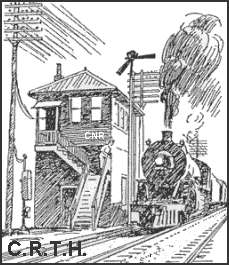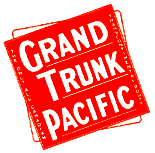 ...I got a thing about Trains.
...I got a thing about Trains. ...I got a thing about Trains.
...I got a thing about Trains.

 The Music of the Rails:
The Music of the Rails:"Wreck of the 1262"-Doc Watson "Wreck of the Old 97", "The Engineers Child", "Ben Dewberry's Last Run", "Golden Rocket"-Hank Snow "Waitin' for a Train"-Jimmy Rodgers "Orange Blossom Special"-Everybody "The City of New Orleans"-Willy Nelson, "Hobo's Lullaby"- Woody Guthrie
The CNR main line was about a half mile from my house down the long slope of the hill and across the flat of the swamp, hidden from sight, but not sound, by the trees. As a child I would watch from the front yard, especially in winter, and see the smoke of the engines puffing up above the trees. It was the time when the railroads were switching from steam to diesel and there was a period when the steam engines were converted from coal fired to oil fired and all three types opf engine would pass during the day. You could tell which kind of head-end was on a train from the smoke (or lack thereof) it emitted. Coal fired steam engines left a trail of grey and white smoke which went high in the air, oil fired steam left pure white smoke which floated low along the tree line, and the diesels a wisp of brown quickly dissipated in the sky. The diesel air horn was a big improvement as a warning device for the trainmen and those who wanted to cross the tracks safely, but at the risk of sounding like an old fart, I still say they lacked the romance of the old steam whistle, especially the ones on the big road engines.
Sometimes when I was visiting my grandparents we would take a truckload of filled cream cans to the station at Wabamun to catch the train to the dairies in Edmonton. It was neat to walk along the wooden platform and see the high wheeled freight carts waiting for loads. The station master/telegrapher had a booth with windows on three sides which stuck out the front of the station and you could hear the telegraph key clicking through the open window. The station master had a long (6?-8? ft.) stick with a wide "Y" at the end, across this he would stretch a loop of cord with a message tied to it. When the trains which didn't stop (most of them) roared through the station, he would hold up this stick and the fireman(?) would stretch out his arm and catch it, exciting to watch.
 The engineer and conductor would always wave to kids much as they do today, no doubt it's an important part of training for the job. The conductor and brakeman used to wave from the caboose, but no more. My late father-in-law, a CPR railwayman for over forty years, always said that a train without a caboose just didn't look finished, and I agree with him.
The engineer and conductor would always wave to kids much as they do today, no doubt it's an important part of training for the job. The conductor and brakeman used to wave from the caboose, but no more. My late father-in-law, a CPR railwayman for over forty years, always said that a train without a caboose just didn't look finished, and I agree with him.
We kids would go "down below" and watch the engineer oiling the train with his long oilspout when they were shunting cars. The mattress ticking overalls and cap, blue shirt and red bandana were a uniform known and respected.
When we walked out the wye intersection to the main line we could wave to the men riding the flat cars and sometimes in the boxcar doors, there were hoboes in the earth in those days.
I was lucky enough to have been in at the end of the "romantic" era in railroading. It was a time when you could see the machinery at work and the men who controlled those mighty masses hurtling past on the tracks. No doubt the new ones are more comfortable and safer and far more efficient, but they don't write songs about them.



 Alberta Railway Museum Great place, you can look practically everywhere. Wear comfortable clothes and be prepared to do a lot of climbing.
Alberta Railway Museum Great place, you can look practically everywhere. Wear comfortable clothes and be prepared to do a lot of climbing.